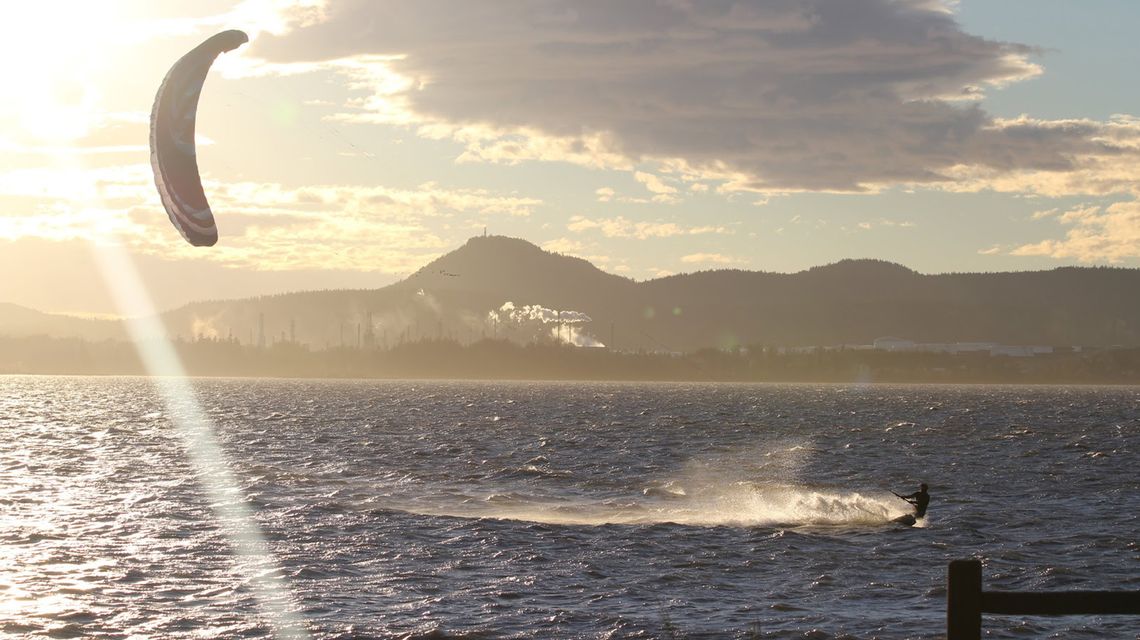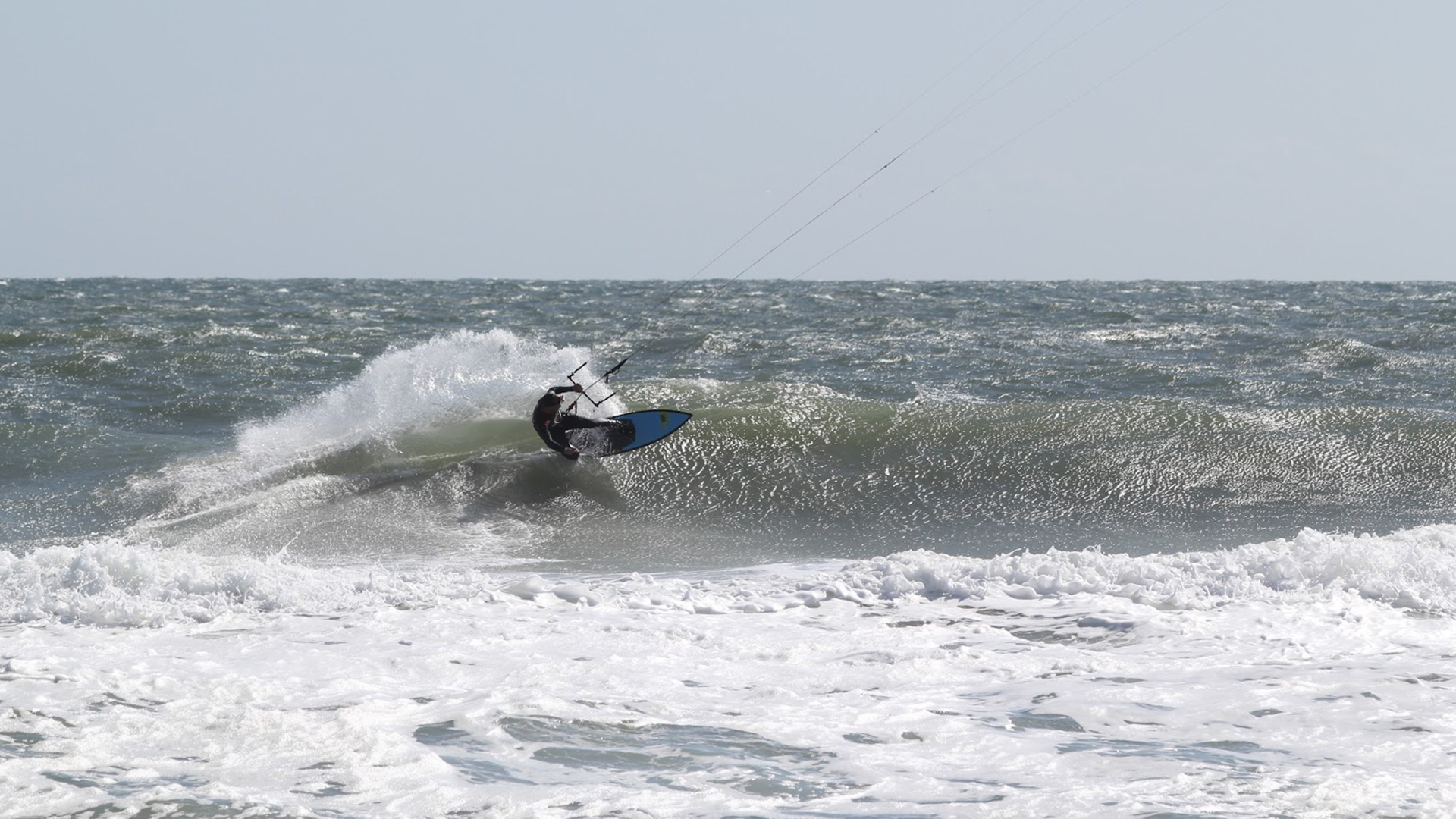
The culture of kiteboarding: When the wind blows, there they go!
BELLINGHAM, Wash. (BVM) — It’s no wonder that kite surfing/boarding is so popular in Washington. The local waterways provide idyllic conditions for this extreme sport, and people of all skill levels can usually find a good “cross on shore” wind to get started or a strong down-winder that can take them for miles. The culture of “go when the wind blows” invites positive, spontaneous vibes that inspire immediate action and an acute sense of awareness. Perfect for the thrill seeker in us all.
Shad Malone, president of the North Sound Kiteboarding Association (NSKA), shares his love and 10-year experience as a ‘big air’ kite surfer. His twin tip Ram Air foil kite and unique skills allow him to ride air currents at 25 mph while lofted 30 feet above the waves.
“The perfect sessions for me are kiting at Locust at mid-tide where the water is anywhere from 3 or 4 inches to a couple of feet deep and it’s like that for miles,” Malone said.
According to Malone, because Locust is on a river delta, it’s a low-lying flat tidal delta with very shallow water. The ideal conditions could easily find Malone 30 feet above the water and still loving it.
“Kiting there on a low tide (where the waters are really shallow) on a sunset evening in the summer – where the air temperature is about 75, the water temperature is about 65, and the wind is blowing about 20 mph. That’s where it’s at for me!”

This naturally “socially distant” sport is subject to only the wind direction and the time of year. Kiting season typically begins in April and curbs in September. With no shortage of locations to choose from (should the right breeze blow their way), both coastal and intercoastal sites can be very attractive – depending on a kiter’s style and skill level.
“It’s a very addictive sport,” Malone explained. “It’s not only adrenaline. It’s endorphins, it’s dopamine. It’s all of these potent natural drugs that you’re getting!”
However, it’s always important to respect the forces of nature, and this sport carries inherent risks. Before launching your first run, it is absolutely imperative to learn some basic industry terms. Understanding sheathing, twisting, and backstalling could save a person from literally being swept out to sea or sent careening into the shoreline at 25 to 30 mph.
An adventurous novice might also want to understand “wind shadowing”. A few training courses will teach just that. International certification can be obtained at Urban Surf in Seattle. Now in operation for 35 years, Urban Surf is the only IKO-certified training course in the state. Before diving into an IKO class, though, it’s a good idea to familiarize oneself with the basics.
“Locust Beach is the best beginners beach in the state,” Malone said. “Kite Paddle Surf has great lessons!”
Kite Paddle Surf is a local shop specializing in equipment rentals and training lessons. As of July 2020, lessons have been postponed due to COVID-19. However, store manager Dave “DJ” Johnson and his team aren’t letting that keep them out of the water. They plan to resume lessons as soon as possible. In mid-August Locust Beach slows down and the winds dictate a move south.
Also, with its laid-back atmosphere and predictable tidal patterns, Locust Beach can also offer respite for those used to the high-energy, densely-packed Jetty Island scene.
Just as notable (for different reasons, of course) is the Columbia Gorge Hood River, known simply as “the Gorge”. The Hood River cuts horizontally through the countryside and is a natural border between Washington State and Oregon’s luscious wine country. Considered a National Scenic Area (and one of Washington’s treasured wonders), it’s hard to talk about kiteboarding culture without mentioning it.
“Down in the Gorge, the winds are blowing 35 mph, and you’re in the river waves,” Malone exclaimed. “It is just nutty; it’s so fun!”
The Gorge is a destination for numerous windsports. Each year, from May through August, this beautiful wine country landscape is filled with windsporters. Kiteboarders from all over the world visit the Gorge for its sheer magnitude, amped-up space and extremely predictable winds, which all make it ideal for competitions.
“The Gorge is like the Mecca of windsports – both locally and worldwide,” said DJ.
Hot, thermal, northwesterly winds fuel events like Bridge of the Gods, the Hood River Junior Jam and the Huckfest Big-Air competition – just a few events that will be missed in 2020. Still, the sport is as spry as ever because where the wind blows, the kiteboarders go.
It’s more than a sport: it’s a culture.
“The winds and the tides don’t wait, so you need a flexible schedule,” Malone explained. “You have to be able to go!”
Passionate kiteboarders are constantly on the lookout to “see where the wind can take them,” and then they chase it. Always prepared for the “perfect conditions,” they watch the weather, review wind sensor information and connect regularly with local kiteboarding forums.
This “together we’re better” attitude encourages community, positivity and safety. Weather conditions are openly reported on websites like Washington’s Kite Surfing Map from the Puget Sound Kiteboarding Association. Clubs like NSKA maintain private wind sensors as part of their organization’s safety protocol, and their readings are openly shared. These updates also help feed the appetite of an avid kiteboarder’s lifestyle.
“There’s a huge safety component here,” Malone says. “The culture is driven by a safety requirement, and that creates a more open kind of sharing environment.”
Kiteboarders share a love for the sport (and the endorphins that come with it). And when the wind blows in their favor, they’re off to catch it – wherever it may take them. This is the kiteboarding culture.






